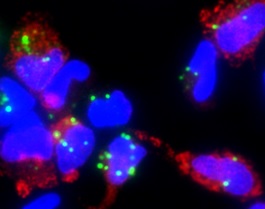By: Jørgen Stenvik
Researcher at Centre of Molecular Inflammation Research (SFF-CEMIR), Department of Cancer Research and Molecular Medicine (IKM)
(Photo: Geir Mogen / NTNU)
CEMIR researchers have published a study in The Journal of Immunology that may aid in the development of new strategies for prevention or treatment of infectious diseases. The study improves our understanding of how bacteria activate the human defense system.
The family of Toll-like receptors (TLR1 to TLR10 in humans) recognizes different molecules of bacteria and viruses. Extensive studies over the last two decades have clarified that these receptors are central in the activation of the innate defense system during infection. The role of TLR8 has still remained enigmatic, as the human receptor can be activated by various types of RNA (ribonucleic acid, a copy of DNA), while murine TLR8 appears non-functional.

Human monocytes (nuclei, blue) infected with Staphylococcus aureus (green). The cells sense the bacteria via receptors, including TLR8, which trigger the production of alarm signals (TNF, red) to fight the infection.
It has been known that human TLR8 can sense viral infection, including HIV, and a possible role of TLR8 in the sensing of the Borrelia bacterium was earlier shown. CEMIR scientists now report that TLR8 also can sense the important human pathogenic bacterium Staphylococcus aureus. This occurs by recognition of bacterial RNA once the bacterium is eaten and degraded inside human defense cells – monocytes and macrophages. The study also reveals new details on how TLR8 triggers alarm cascades inside the cells, which include the activation of the transcription factor IRF5 via a recently described pathway (TAK1-IKKβ). This results in movement of IRF5 to the cell nuclei, where it activates the defense and alarm gene IFNβ, and further contributes to the activation of other alarm genes such as TNF. A surprising finding was that bacterial activation of a second immune receptor, TLR2, which senses lipoproteins at the cell surface, blocks the function of TLR8 inside the cell. This may represent a safety mechanism to avoid exaggerated immune activation that may lead to sepsis syndrome and septic shock. Because TLR2 and TLR8 trigger partially different alarm signals, this cross-regulation might fine tune the immune response towards different classes of pathogens.
The study is published in The Journal of Immunology together with an independent study by a research group from Germany who show that TLR8 also senses Streptococcus pyogenes. It is thus likely that human TLR8 can sense several different classes of bacteria, and that bacterial RNA is more important for the activation of the immune system than has previously been acknowledged.
TLR8 can in principle detect also human RNA, and the study may help to clarify whether TLR8 plays a role also in inflammatory diseases such as chronic inflammation and autoimmunity.
More about the study in The Journal of Immunology
